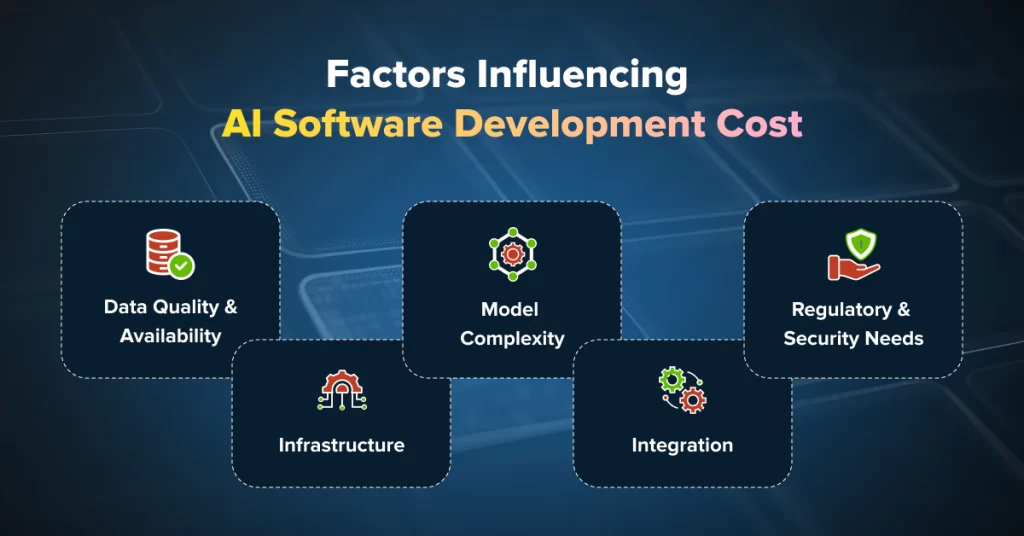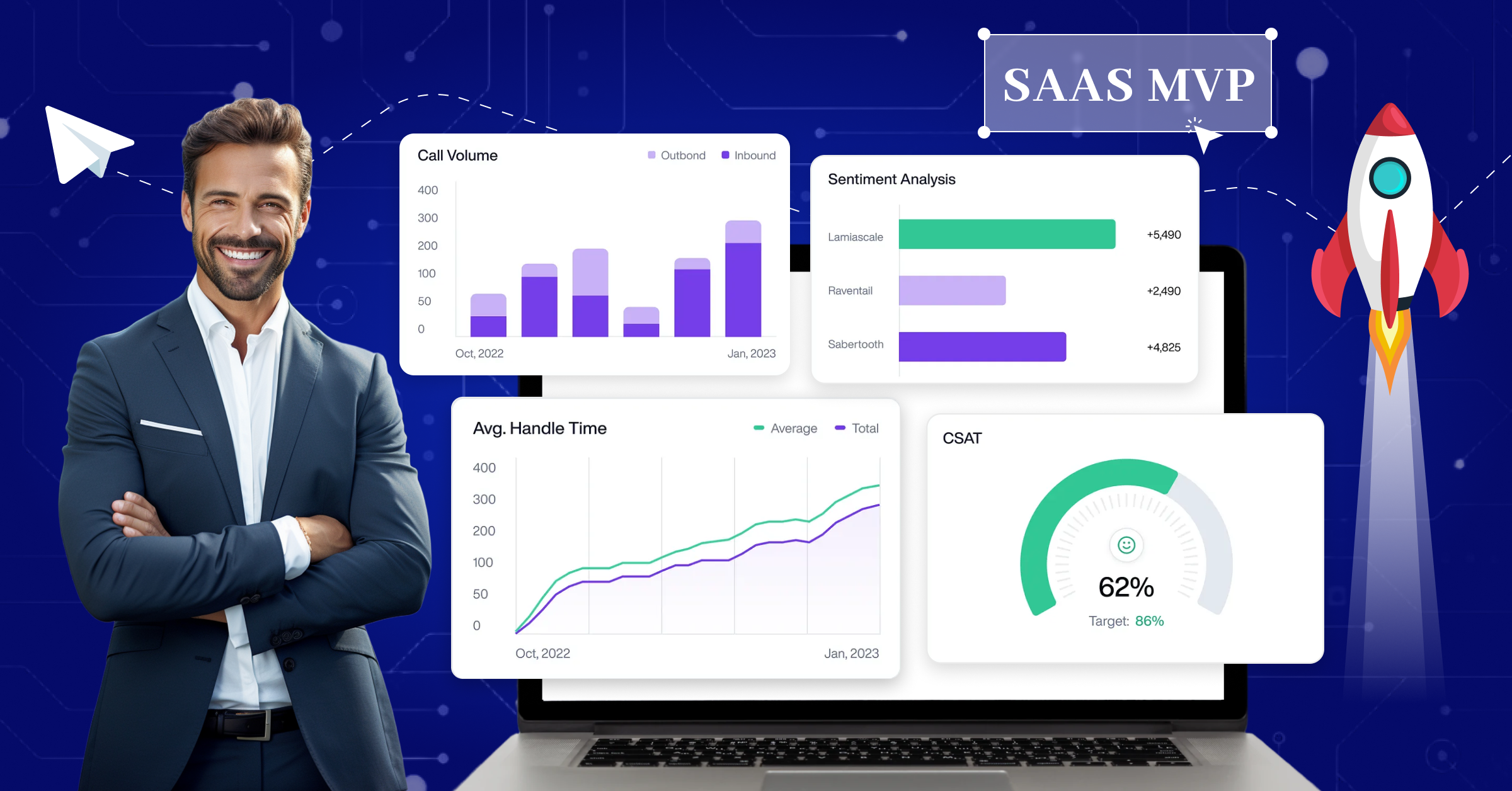AI Development Cost: How Much Does it Cost to Build an AI Software?

$254.50 billion is the projected AI market size in 2026, according to Statista, and it is expected to show an annual growth rate of 36.89% and is expected to reach around $1.68 trillion by 2031. The market will see tremendous growth and innovation continuously with AI becoming a prominent part of business operations.
That is a steep upward curve in the forecast of AI investment. It’s not just about having an automated workflow; it’s about how much competitive advantage a company gets from AI.
So, as an entrepreneur yourself, your next question naturally would be, How much is the AI development cost going to be, and which AI development company to approach?
You are at the right place to get deeper insights into artificial intelligence cost estimation. Let’s get started.
Key Takeaways
- The five biggest cost drivers of AI projects are data quality, model complexity, infrastructure type, integration necessities, and compliance requirements.
- Pre-trained AI models, open-source tools, and cloud infrastructure can reduce 30 to 50% of AI development costs.
- To mitigate risks and prevent overspending, MVP-first development is recommended.
- Outsourcing to the right AI development company reduces costs up to 70% when compared to maintaining in-house teams.
Table of Contents
How Much Does it Cost to Build an AI? A quick analysis
AI pricing typically ranges from $5,000 to over $500,000, depending on the complexity, features, and scale of your project.
- Simple AI solutions with limited functionality fall under low-end: from $5,000 to $25,000.
- Moderate Complexity AI with adaptive intelligence is under mid-range: $50,000 – $250,000+.
- Advanced systems requiring custom algorithms and integrations fall under the higher-end: $100,000 to $500,000.
The cost to build an AI can be challenging for any company, especially if you are a startup or a mid-size enterprise. Now, let us take you through an in-depth analysis of the cost.

| Industry | Common AI Software / Applications | Average AI Development Cost |
| Healthcare | Basic appointment scheduling chatbots, advanced drug discovery platforms, Custom NLP model for clinical notes | $50,000 to $10 million+ And custom solutions cost 30–40% higher than pre-built solutions |
| Banking and Finance | Fraud detection systems, credit scoring AI, robo-advisors, and algorithmic trading bots. | $40,000 to $400,000+ |
| Retail & eCommerce | Recommendation engines, dynamic pricing tools, chatbots AI application development, and demand forecasting models. | $50,000 to $250,000+ |
| Education | AI-powered lesson planning, teacher assistants and chatbots, voice-to-text solutions, ai voice agent development and adaptive parental guides. | $5,000 to $100,000+ |
| Logistics & Transportation | Route optimization, autonomous vehicle AI, warehouse automation. | $40,000 to $70,000+ |
| Energy & Utilities | Smart grid analytics, energy consumption prediction, and equipment monitoring. | $400,000 to $700,000+ |
| Entertainment & Media | Content recommendation engines, deepfake technology, and AI-based video editing. | $8,000 to $150,000+ |
| Human Resources | AI recruiting tools, resume screening, payroll, and performance management. | $75,000 to $500,000+ |
🎯 Project Complexity-Based Cost Breakdown
- Entry-Level Projects: $25K–$60K for basic, rule-based AI.
- Custom AI Solutions: $60K–$150K for ML-powered recommendations or analytics.
- Advanced Systems: $150K–$250K+ for deep learning, NLP, or computer vision apps.
🎯 Other cost influences include
- UI/UX design – Simple screens cost less; interactive dashboards and animations add more.
- Team expertise & location – Global hourly rates vary (India: $30–50/hr, USA: $100+/hr).
- Data needs – The more data your system needs to train on, the more infrastructure you’ll pay for.
This means you should first clarify your use case and budget range before approaching an AI tech partner.
Factors Influencing AI Software Development Cost
Common factors influencing AI cost are
- Data Quality and Availability
- Model Complexity
- Integration
- Regulatory and Security Needs
That said, the cost of developing AI isn’t one-size-fits-all. So, how much does it cost to build an AI system considering these common factors?
Here is a practical breakdown of common factors that drive the cost of implementing AI in business.

✅ Data Quality and Availability
This stage is expensive, accounting for 30-40% of the project budget, making it a major factor in AI development costs.
- Data Collection: Data is collected from internal CRM, ERP, or industry-specific datasets are purchased.
- Data Cleaning: Removing duplicate entries and fixing incomplete data.
- Data Labeling: Annotating raw data helps an AI model learn from it.
- Data Augmentation: Expanding datasets by generating synthetic data.
Example: A retail company trains a demand-forecasting AI by collecting and cleaning sales data, labeling products, and adding synthetic seasonal trends.
✅ Model Complexity
The question, “How much does it cost to develop AI software?” never has a simple fixed answer. It always varies based on the model complexity.
Model complexity defines the depth of algorithms, training data, and processing power needed. The more layers and data it needs, the more time and resources it takes to develop. This directly impacts AI software development cost.
- Simple models, like a recommendation engine or a keyword-based chatbot, are cheaper to develop and take shorter development cycles.
- High complexity models like computer vision systems or image recognition, or NLP, require massive datasets and expensive infrastructure costs.
✅ Infrastructure
Infrastructure covers servers, storage, and cloud platforms, and it has a major role in influencing the AI development cost.
As an enterprise owner, think of infrastructure as a long-term investment that future-proofs your AI system and scales as the workload increases. Here are some examples.
- The AI-compute costs rise with complex neural networks, deep learning models that require large datasets, or projects involving computer vision.
- The hybrid approach combines both on-premise servers with cloud platforms for a balance of high performance and data protection.
- Lastly, tech stack selection involves choosing the right mix of programming languages and frameworks. This reduces rework and minimizes integration issues.
✅ Integration
Integrating AI into existing systems heavily depends on the existing system architecture. Projects that require deeper customization and integration significantly increase AI software development costs.
Potential risks when adding AI to an existing system
- Cloud computing costs rising faster than expected.
- Additional compliance and security requirement expenses.
- An AI model failure leading to inaccuracy.
How to reduce risks:
- Conduct budget projections before full rollout.
- Begin with a small dataset before scaling up.
- Monitor AI performance consistently to prevent performance decay.
✅ Regulatory and Security Needs
Security and regulatory requirements add a layer of AI development cost. Ignoring these requirements will lead to penalties and also increase the cost of developing AI.
- Regular audits to reduce bias and maintain fairness increase operational costs.
- Compliance with standards like GDPR and HIPAA requires data handling and dedicated workflows.
- Implementing encryption, authentication, and threat monitoring increases the cost.
9+ Tips on Cutting the AI Development Cost
Here’s what works when you want to cut down the cost of AI development without compromising quality:
- Open-source tools: Speed up deployment and avoid licensing fees.
- Pre-trained models: Reduce training costs and time.
- Cloud-based AI: Offers flexibility at a lower cost.
- Agile development: Reduces development cycles.
- Outsourcing: Cuts unnecessary hiring and training costs.
These proven strategies to optimize AI development cost ensure smart spending. Let’s take a detailed look.
1️⃣ Use Open-Source Tools
Using open-source AI tools such as PyTorch, Keras, and scikit-learn reduces the cost of implementing AI in business since it eliminates licensing fees and reduces the development cycles.
Even ChatGPT, which gets over 4.61 billion monthly visits, depends on similar open frameworks. This proves that open-source tools can drive innovation for businesses of all sizes.
So, how much does it cost to build an AI with open source tools? Studies show that companies would spend nearly 3.5× more without them. Open-source development reduces the cost of AI development while encouraging faster innovation and scalability.
2️⃣ Start With Pre-Trained Models
Pre-trained or pre-built models are trained on massive datasets that can be adapted to your business needs.
This cuts down the cost of developing AI as you only pay for fine-tuning rather than investing in full-scale AI model training. In fact, startups can reduce AI development costs by 50% using pre-trained models.
Example: An e-commerce company can start with a pre-trained recommendation engine like TensorFlow Recommender and just add their inventory data to it.
So when you ask yourself, “How to optimize artificial intelligence development costs?” look for pre-trained models that give you a head start.
3️⃣ Choose Cloud-Based AI Services
Go for cloud-based AI services like AWS SageMaker, Microsoft Azure AI, and Google Cloud AI to eliminate the infrastructure costs of buying servers or GPUs.
- Did you know that AWS has reduced the price of Amazon SageMaker by 45% which has made generative AI model training more cost-effective?
- Pricing models for AI development in these platforms are flexible with pay-as-you-go options and scalable compute pricing to align with real-time usage.
- So, how much does AI development cost with cloud-based AI services? Organizations that use cloud-based AI solutions have seen up to 30% cost reduction.
Now, didn’t that make the cloud vs. own hardware decision easy for you?
4️⃣ Adopt Agile Practices
Agile method shortens development cycles with manageable sprints and iterative testing and feedback loops. This approach helps avoid unnecessary rework and lowers the AI software development cost.
The next natural question would be how much does it cost to build an AI system with agile methodology. To give you a general benchmark, teams that adopt agile methodology have seen about 20 to 30% cost reduction and improved performance.
5️⃣ Optimize Data Collection
Optimizing your data helps maintain model accuracy. Poorly structured or missing data can lead to delayed training and increased expenses.
To avoid this, collect data from relevant sources, clear out duplicates, and invest in structuring and labeling. Some consider data cleansing as one of the hidden costs in AI development, since overlooked errors can quietly inflate budgets.
Now, how much does it cost to build an AI if you skip proper data optimization? In most cases, neglecting data preparation can add 30% to overall AI development costs, making upfront investment in clean, structured data a smart, cost-saving move.
6️⃣ In-House vs. Outsourcing AI Development
How much does AI development cost varies drastically depending on whether you hire internally or work with external experts.
| Aspect | In-House AI Development | Outsourcing AI Development |
| Cost Efficiency | Very high costs: recruitment, salaries, tools, and infrastructure – around $176,000-300,000 | Much cheaper: $60,000-160,000/year |
| Talent Access | Needs to hire niche AI engineers (typically $120-250 +/hour in the US). | Access to professionals across the world at a rate of $25-50/hour (India) without permanent employment. |
| Infrastructure & Tools | Will need to spend on servers, GPUs, cloud, and licenses. | Every infrastructure is offered by the vendor. No capital investment. |
| Speed of development | Slower because of hiring, onboarding, and developing everything from the ground up. | Quickened delivery through established teams, prebuilt workflows, and processes. |
| Scalability & Flexibility | Difficult to scale within a short time; constrained by internal capacity. | Scalable easily- add or remove resources on the fly depending on the project. |
7️⃣ Use AutoML Tools
AutoML tools automate repetitive tasks and help optimize resource allocation, which makes it essential in artificial intelligence cost estimation.
For example, a healthcare provider can implement Azure AutoML to forecast patient readmissions. This cuts development time and increases model accuracy.
Did you know that data scientists spend 70% of their time developing AI models? But AutoML speeds up this process and lets them focus on high-value tasks.
How much does it cost to build an AI system if you use AutoML tools? Businesses have reported saving around $2,000 per month by automating repetitive AI tasks with AutoML.
9️⃣ Focus on MVP Development
In a market where AI implementation is making even the loss-making startups turn towards trillion-dollar valuations, building an MVP is a cost-effective way to test before fully investing.
An MVP (Minimum Viable Product) means creating a prototype with only must-have features to validate the concept. This approach cuts the cost of developing AI and minimizes risk.
This can reduce your AI development cost from $28,000 to $10,000. For AI projects with moderate complexity, the MVP cost falls between $30,000 and $80,000 if they involve custom ML workflows.
Launching an MVP lets you gather real-world feedback and improve your features based on that.
🔟 Monitor Operational Costs
Keeping AI software development costs at bay doesn’t just end at deployment. You need to watch out for:
- Storage costs: Remove any idle CPU/GPU to cut costs.
- Model maintenance: The data updates and maintenance to prevent data drift can cost 10 to 20% of the original development costs.
- Compliance and monitoring: Regular updates are necessary to maintain data privacy and prevent security issues.
How Much Does It Cost to Integrate AI into an Existing Product?
When you are adding AI as a feature instead of creating a separate system, you may wonder how much does AI cost to integrate into an existing product.
Here, AI Development cost estimation will be greatly dependent on the level of modernity and scalability of your recent infrastructure. Older platforms need refactoring or upgrades to the backend that can add up-front costs.
Here is an example to show AI pricing between AI Integration vs. AI Development Cost Breakdown.
👉 Building an AI Product from Scratch
Estimated Cost: $40,000 – $500,000+
What’s Included:
- AI solution design and development.
- Data preparation and data collection.
- Training and optimization of AI models.
- The backend configuration and system architecture.
- UI/UX design and testing
- Installation and maintenance.
👉 Integration into Existing Software
Estimated Cost: $10,000 – $150,000+
What’s Included:
- AI API plug-ins or a pre-trained model integration.
- The predictive analytics or AI-based automation.
- Backend changes and compatibility modifications to legacy systems.
- Testing, tuning, and monitoring of performance.
In short, the cost of implementing artificial intelligence into an existing system is determined by the architecture of your product, the amount of customization you need, and the scope of AI functionality you plan to add.
How CONTUS Tech Can Help with AI Development?
Now that you have a clear idea of artificial intelligence cost estimation, let’s take a look at what working with the right AI development partner can look like and help you cut unnecessary costs.
Choose a company like CONTUS Tech that has deep AI expertise across various industries. Their 150+ dedicated AI developers specialize in AI software development, AI agent development services, agentic AI services, and custom AI solutions tailored for different business needs.
Also, you get 40% workflow efficiency boosts and 30% faster time-to-market as they deliver AI POCs in 2 to 8 weeks.
All of this combined ensures that you stay ahead of the competition without overspending or delaying your development cycles.
FAQ’s About AI Software Development Cost
Can I create my own AI software?
When building your own AI, it’s better to go for pre-trained models, open-source tools, and no-code platforms if it’s a basic AI solution. If you are looking to build AI software with deeper customization, then go for programming languages like Python and AI frameworks like TensorFlow or Keras.
How much does it cost to build your own AI?
A simple AI project, like chatbots, could cost around $20,000, advanced AI systems like recommendation engines around $50,000 to $150,000+, and customized AI solutions like medical diagnosis systems can go from $100,000–$500,000+.
Can I create an AI model of myself?
Yes, you can create an AI model of yourself using no-code/low-code platforms for quick setup, AutoML for a balanced approach, or traditional programming with Python and libraries like TensorFlow for full customization, depending on your technical expertise and desired control.
What are the challenges in estimating ROI of AI projects?
Estimating the ROI of AI projects can be difficult as the outcomes are intangible, data quality issues, and development cycle delays. Integration issues, hidden infrastructure costs, and unclear performance metrics make it harder to set ROI.
Is AI Development Cost-Effective for Small Businesses?
AI development can be cost-effective for small businesses if implemented strategically. Ready-made AI tools can be used for areas like customer support without major investments. But custom models need evaluation of long-term gains vs development cost.
AI software price insight: what’s the average cost for mid-sized companies?
For mid-sized companies, AI software price can be based on subscription fees and multi-stage development. API-based or SaaS AI tools can range from $50,000 to $250,000. Custom AI can be anywhere between $500,000 to $1 million.
What Are the Hidden Costs in AI Development?
Data prep and cleaning are the most common hidden costs in AI development. Storage, model retraining, system integration, data security regulations, and bias mitigation are a few other factors behind the hidden costs.
Connect With Our Team, Discuss Your AI Development Requirements, and Begin Your Project in Just Next Few Days.



